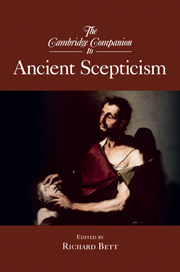Book contents
- Frontmatter
- Introduction
- Part I Origins and Development
- Part II Topics and Problems
- 7 Scepticism and belief
- 8 Scepticism and action
- 9 Scepticism and ethics
- 10 Academics versus Pyrrhonists, reconsidered
- 11 The Pyrrhonian Modes
- 12 Pyrrhonism and medicine
- 13 Pyrrhonism and the specialized sciences
- Part III Beyond Antiquity
- Bibliography
- Index
- Index Locorum
13 - Pyrrhonism and the specialized sciences
from Part II - Topics and Problems
Published online by Cambridge University Press: 28 March 2010
- Frontmatter
- Introduction
- Part I Origins and Development
- Part II Topics and Problems
- 7 Scepticism and belief
- 8 Scepticism and action
- 9 Scepticism and ethics
- 10 Academics versus Pyrrhonists, reconsidered
- 11 The Pyrrhonian Modes
- 12 Pyrrhonism and medicine
- 13 Pyrrhonism and the specialized sciences
- Part III Beyond Antiquity
- Bibliography
- Index
- Index Locorum
Summary
A PRELIMINARY AGENDA
“Having said this much against the principles of music as well, basing ourselves effectively on factual data (pragmatikôs), at this point we bring to an end our disquisition against the objects of instruction in the liberal arts (mathêmata).” These are the closing lines of the compact set of treatises Sextus Empiricus devotes to the demolition of the so-called liberal arts (M 1-6, or more precisely: M 1, Against the Grammarians; M 2, Against the Rhetoricians; M 3, Against the Geometers; M 4, Against the Arithmeticians; M 5, Against the Astrologers; M 6, Against the Musicians ). Before confronting problems of some importance concerning the placing of this work and its type of scepticism, it is worth at least touching on two questions.
The first has to do with whether or not it is possible to attribute to Sextus an already systematized version of the “canon” of liberal arts, divided into a trivium (grammar, rhetoric, dialectic) and a quadrivium (arithmetic, geometry, astronomy, music).
- Type
- Chapter
- Information
- The Cambridge Companion to Ancient Scepticism , pp. 249 - 264Publisher: Cambridge University PressPrint publication year: 2010
- 4
- Cited by

